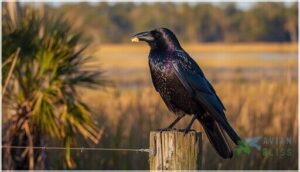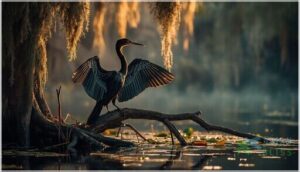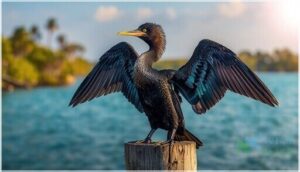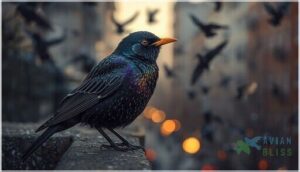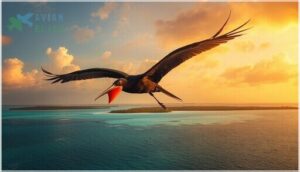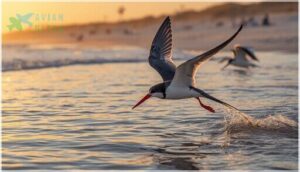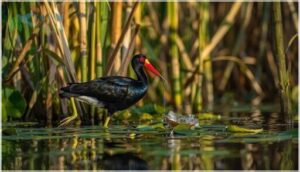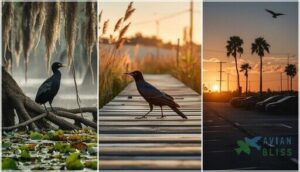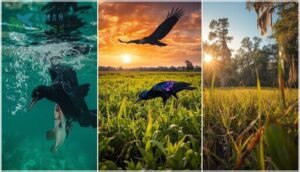This site is supported by our readers. We may earn a commission, at no cost to you, if you purchase through links.
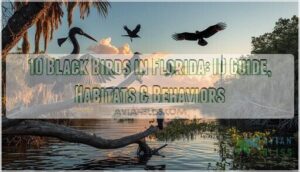
You’ll spot them perched on power lines, gliding low over coastal waters, or stalking fish in shallow wetlands—black birds in Florida dominate the state’s avian landscape with a variety that surprises even experienced birders. From the intelligent American Crow to the dramatic Splendid Frigatebird with its seven-foot wingspan, Florida’s dark-plumaged species occupy nearly every habitat the peninsula offers.
These birds aren’t just background noise in your backyard; they’re specialized survivors with hunting techniques ranging from the Anhinga’s underwater spear-fishing to the Black Vulture’s keen nose for carrion.
Understanding which species you’re observing requires more than noting color—bill shape, size, behavior, and habitat all provide critical clues that separate a common grackle from its boat-tailed cousin or distinguish a cormorant from an anhinga at distance.
Table Of Contents
- Key Takeaways
- Common Black Bird Species in Florida
- Distinctive Features of Florida’s Black Birds
- Habitats and Distribution Across Florida
- Feeding Habits and Behaviors
- Conservation and Human Interaction
- Frequently Asked Questions (FAQs)
- How many black birds are there in Florida?
- Are there black pigeons in Florida?
- Are blackbirds invasive in Florida?
- What birds live in Florida?
- Is there a more beautiful black bird in Florida?
- What do black birds eat in Florida?
- Typical black birds in Florida include what species?
- What are those loud black birds throughout Florida?
- What is the common black bird in Florida?
- What are the black birds that look like crows in Florida?
- Conclusion
Key Takeaways
- You’ll identify Florida’s black birds by combining bill shape, size, and behavior with habitat—distinguishing an Anhinga’s spear-like bill for impaling fish from a cormorant’s hooked beak for grasping prey, or separating Common Grackles from Boat-tailed cousins by mass and tail structure.
- Florida hosts over 20 dark-plumaged species occupying specialized niches from coastal skimmers and frigatebirds with seven-foot wingspans to freshwater marsh-dwellers like gallinules and urban scavengers including crows and starlings.
- Conservation status varies dramatically across species—Common Grackle populations have crashed 50-78% while Black Vultures surge upward, creating management challenges that balance ecological benefits like carrion removal against agricultural damage exceeding millions annually.
- Most Florida black birds remain federally protected under the Migratory Bird Treaty Act, making unauthorized harm a third-degree felony with substantial fines, though invasive European Starlings represent the sole exception among the state’s dark-plumaged species.
Common Black Bird Species in Florida
Florida’s skies, wetlands, and coastlines host a striking variety of black-plumaged birds, from scavengers and divers to marsh-dwelling foragers. Each species brings its own set of behaviors, adaptations, and ecological roles that shape the state’s diverse avian landscape.
Here are ten black birds you’re likely to encounter across Florida’s habitats.
American Crow
You’ll find the American Crow throughout Florida, a master of urban adaptation with exceptional crow intelligence. These glossy black birds in Florida thrive wherever opportunity knocks—farms, wetlands, even city parks.
- Social learning lets them recognize individual human faces and pass knowledge through family groups
- Foraging strategies range from scavenging roadkill to caching surplus food for later retrieval
- Nesting habits involve cooperative breeding, with young helpers assisting parents for multiple seasons
- Flexible omnivores consuming everything from insects and grains to carrion and human food waste
The American Crow’s diet consists of an omnivorous food source variety.
Boat-tailed Grackle
Crows share streets with the Boat-Tailed Grackle, another brazen urban adapter you’ll spot strutting parking lots and marsh edges. Males reach 43 cm—nearly twice a female’s mass—with iridescent purple-black plumage and that namesake keel-shaped tail.
| Feature | Male | Female |
|---|---|---|
| Length | 38–43 cm | 28–33 cm |
| Mass | 145–190 g | 90–120 g |
| Plumage | Iridescent black-purple | Brownish with darker wings |
These omnivores scavenge trash, raid heron nests, and snatch aquatic invertebrates with equal opportunism across Florida’s wetlands and cities. They thrive in their preferred coastal saltwater habitats.
Anhinga
You’ll recognize the Anhinga by its snake-like neck and spear-straight bill—perfect aquatic adaptations for impaling fish mid-dive. Males reach 87 cm with jet-black plumage; females sport tawny necks.
Unlike grackles, these diving specialists haunt freshwater marshes and cypress swamps, spreading waterlogged wings to dry after hunting.
Their nesting habits favor shrub colonies over water, where incubation takes 25–30 days and Anhinga migration patterns shift southward each winter.
Double-crested Cormorant
While Anhingas wield dagger bills, you’ll spot Double-crested Cormorants by their hooked beaks—precision tools for grasping slippery prey. These black waterbirds haunt Florida’s coastlines and inland lakes, where diving techniques send them 25 feet deep after mullet and pinfish. Their feather maintenance ritual is unmistakable: wings spread wide on pilings, drying waterlogged plumage in the sun.
- Males reach breeding age at three, displaying zigzag swims and wing-flapping to attract mates
- Colony dynamics support mixed-species nesting in mangroves and lakeside trees throughout the state
- Aquatic adaptation includes cormorant migration to ice-free Florida waters each winter
- Over 12,000 breeding pairs establish colonies from the Keys to the Panhandle
- Diving sessions attract opportunistic snappers and grunts hunting disturbed prey below
Black Vulture
Soaring on broad wings, Black Vultures dominate Florida’s carrion feeding circuit year-round—190 million strong across North America, with populations climbing 3.4% annually.
You’ll see roosting patterns centered on towers and trees near landfills, where scavenging behavior fuels family groups hunting roadkill and livestock carcasses.
Nesting habits favor wooded edges, though vulture migration barely touches this subtropical stronghold where black birds thrive in every habitat.
Common Grackle
Iridescent plumage catches your eye in parking lots and wetlands—Common Grackle populations now hover near 70 million birds despite a 60% North American decline over four decades. You’ll recognize this near-threatened species among black birds in Florida by:
- Pale yellow eyes contrasting with black feathers that shimmer blue-purple
- Grackle diet switching from beetles to acorns seasonally
- Bird flocking behavior creating winter roosts exceeding one million individuals
Grackle migration barely registers here; nesting habits span February through July statewide.
European Starling
Glossy European Starlings arrived in Florida through invasive ecology, tracing back to 100 birds released in 1890 New York. You’ll spot these black bird species by their iridescent feather coloration—purple-green sheen in breeding plumage, white speckles in winter—and their 2.5–3 cm pointed bills.
Nesting habits fill cavities March through July, while starling migration brings northern flocks into urban roosting sites alongside grackles each fall.
Magnificent Frigatebird
You’ll recognize the Splendid Frigatebird by its forked tail and seven-foot wingspan—adult males sport inflatable red throat pouches during frigatebird nesting season.
These coastal ecology specialists practice kleptoparasitism, harassing other seabirds mid-flight for food.
Birdwatching tips: Scan southern Florida’s coastlines year-round, especially the Keys, where these black birds in Florida soar without landing, representing unique bird species in Florida wildlife and seabird conservation priorities.
Black Skimmer
You’ll spot the Black Skimmer’s striking feeding technique as its elongated lower mandible slices through Florida’s coastal waters like a blade through silk—capturing roughly one fish every five minutes. This state-threatened bird species in Florida nests on sandy beaches, facing pressure from development and disturbance.
- Colonies range from a few pairs to hundreds
- Forages primarily at dusk and night
- Requires protected beach conservation areas
- Shows strong sexual dimorphism in size
Skimmer migration patterns connect Florida’s breeding colonies with wintering grounds across the Gulf, making colony dynamics and nesting habits critical for bird identification and conservation of these unique black birds.
Common Gallinule
You’ll find the Common Gallinule foraging along Florida’s marshes year-round, its red and yellow-tipped bill catching your eye against dark plumage. This medium-sized rail demonstrates striking species adaptation to wetland ecology, swimming while picking surface plants or up-ending to reach submerged vegetation.
| Feature | Description | Significance |
|---|---|---|
| Size | 30–38 cm, 300–400 g | Between coots and smaller rails |
| Habitat | Freshwater marshes, canals | Year-round resident across Florida |
| Diet | Aquatic plants, insects, snails | Omnivorous foraging strategies |
| Nesting Habits | 8–12 eggs, May–August | Floating vegetation platforms |
| Conservation | Declining 1.5% annually | Wetland loss threatens populations |
Bird migration patterns show spring movements in northern Florida from late March through April, while nesting habits favor dense cattail stands. For birdwatching in Florida’s wetlands, watch these black birds climb through emergent vegetation—a behavior distinguishing them from diving waterfowl in wildlife observation.
Distinctive Features of Florida’s Black Birds
Not all black birds in Florida look alike—once you know what to watch for, you’ll spot key differences that make identification much easier. From the broad wingspan of a frigatebird to the striking bill shapes adapted for hunting or scavenging, these features tell you exactly what you’re seeing.
Let’s break down the physical traits and behaviors that set Florida’s black birds apart.
Size and Wingspan Differences
You’ll notice striking size variation among Florida’s black bird species, a critical aid to bird identification in the field. Body length ranges from compact 20–23 cm European Starlings to impressive 89 cm Anhingas.
Wingspan differences are even more dramatic—Common Grackles span roughly 36–46 cm, while Superb Frigatebirds reach a remarkable 2.17–2.44 m. These wingspan ratio differences directly influence flight patterns and foraging behavior across species.
Unique Plumage and Color Patterns
Beyond sheer wingspan, you’ll distinguish Florida’s black birds by their striking plumage variations. Boat-tailed Grackles flash glossy coats with iridescent feathers showing purple-blue sheens, while Black Skimmers pair black upperparts with crisp white undersides. Male Splendid Frigatebirds wear uniform black plumage offset by inflatable red throat pouches. Anhingas display distinctive silvery back streaks against dark bodies—color morphs and feather patterns that make field identification surprisingly straightforward once you know what to watch for.
Bill Shape and Feeding Adaptations
Bill shape reveals how you’ll catch these birds in action. Anhingas wield spear-like bills with serrated edges—perfect for impaling fish underwater. American Crows pack stout, all-purpose beaks that tear carrion and crack nuts. Black Skimmers sport wildly uneven bills, the lower mandible slicing through water to snag prey by touch alone.
Each beak morphology mirrors dietary specializations, turning feeding strategies into living blueprints of survival.
Vocalizations and Behavior
You’ll hear these birds before you spot them—vocal learning separates Florida’s black birds into distinct sound profiles. Listen for:
- American Crows: 7-9 unique call types during daily interactions, from sharp warnings to cooperative rallying cries.
- Red-winged Blackbirds: Over 100 vocalization patterns, including the signature “o-ka-leeee” territorial song.
- Grackles: Harsh calls marking aggressive displays and communal roost negotiations.
Bird communication intensifies during breeding season, when males spend 25% of daylight hours defending territories through social calls and tactical aggression.
Habitats and Distribution Across Florida
Florida’s black birds don’t stick to one type of landscape—they’ve carved out territories from saltwater coasts to freshwater swamps and even the parking lots where you grab your morning coffee.
Each species has adapted to specific environments across the state, whether that’s wading through marsh grasses, soaring over beaches, or scavenging in suburban neighborhoods.
Understanding where these birds live helps you know exactly where to look when you’re ready to spot them in the wild.
Wetlands and Marshes
You’ll find Florida’s black birds thriving where water meets land—wetlands and marshes shelter roughly one-third of the state’s bird diversity. Anhingas stalk fish in freshwater swamps, while Double-crested Cormorants patrol open lakes, both exploiting aquatic habitats shaped by centuries of ecosystem management. Common Gallinules nest in cattail stands, and Boat-tailed Grackles prowl mudflats where marsh conservation efforts protect critical breeding grounds.
| Species | Preferred Wetland Type |
|---|---|
| Anhinga | Freshwater swamps, slow rivers |
| Double-crested Cormorant | Lakes, marshes with open water |
| Common Gallinule | Emergent vegetation marshes |
| Boat-tailed Grackle | Salt and freshwater marsh edges |
| Black-crowned Night-Heron | Mangrove swamps, vegetated shores |
Despite losing half of Florida’s original 20.3 million wetland acres, remaining marshes sustain waterbirds through bird migration seasons and year-round residency. Wildlife in Florida depends on these aquatic habitats—protected refuges like the Everglades and Merritt Island anchor populations of fish-eating specialists and omnivorous marsh dwellers alike.
Coastal and Beach Areas
Along Florida’s Atlantic and Gulf shorelines, you’ll encounter black-plumaged coastal bird species adapted to beach nesting and fluctuating shoreline management challenges. Black Skimmers occupy sandy beaches and estuaries, while Fish Crows patrol the coast year-round. Boat-tailed Grackles colonize saltwater marshes bordering bays.
Coastal erosion and habitat restoration shape where these water birds breed—symbolic fencing now protects imperiled colonies during bird migration and nesting seasons across Florida’s developed beaches.
Urban and Agricultural Landscapes
In central Florida’s urban planning corridors and agricultural zones, you’ll spot grackles, crows, and starlings thriving where human-wildlife conflict runs high. These birds of Florida exploit farmland and cities year-round, testing landscape ecology and bird habitat loss mitigation efforts.
- Common Grackles crowd shopping centers and suburban lawns, forming roosts thousands strong
- American Crows feast on crop residues and trash across urban–rural gradients
- European Starlings damage corn, sunflower, and winter vegetables, costing producers millions annually
Bird watching in Florida reveals avian ecology shaped by agricultural impact and bird migration timing.
Lakes, Rivers, and Inland Waters
You’ll encounter inland waterbirds like Double-crested Cormorants and Anhingas patrolling Florida’s lake ecosystems and river habitats, where aquatic ecology dictates survival. These avian ecology specialists depend on wetland conservation to maintain breeding grounds and foraging sites across the state’s freshwater systems.
| Species | Inland Habitat Use |
|---|---|
| Double-crested Cormorant | Lakes, ponds, rivers year-round; 66.7% detection on surveyed lakes |
| Anhinga | Freshwater wetlands, open-water lakes; prefers low vegetation coverage |
| Black Skimmer | Occasional inland nesting on freshwater lake shorelines |
| Wood Stork | Large lake margins, floodplains; 3,916 nests in 2021 |
Lake Okeechobee supported 3,793 waterbird nests in 2021, demonstrating how Florida’s inland waters function as critical breeding hubs for black birds and wading species alike.
Feeding Habits and Behaviors
Understanding how Florida’s black birds feed reveals the full picture of their ecological roles and survival strategies. Each species has carved out its own niche, from the Anhinga’s patient underwater stalking to the Black Vulture’s scavenging rounds across open landscapes.
Let’s break down what these birds eat, how they hunt, and the behaviors that define their daily routines.
Diets of Major Black Bird Species
You’ll find striking dietary diversity among Florida’s black birds, reflecting millions of years of ecological specialization. These species have carved out distinct feeding niches across the state’s varied habitats.
- Piscivorous diets: Anhingas and Double-crested Cormorants pursue fish through aquatic foraging in freshwater systems
- Omnivorous habits: American Crows and Boat-tailed Grackles consume insects, small vertebrates, grains, and even human refuse
- Carrion feeders: Black Vultures remove carcasses, dominating scavenging across agricultural landscapes
- Seed consumption: Common Grackles shift to grains and acorns during winter migration
- Herbivorous preferences: Common Gallinules feed primarily on aquatic plant material in marshes
Foraging Techniques and Strategies
You’ll observe striking foraging adaptations across Florida’s black-plumaged species, each reflecting specialized prey capture tactics. Double-crested Cormorants execute aquatic pursuits as foot-propelled divers, generally working depths of 1.5–7.9 m during 30–70-second submersions.
Black Skimmers employ surface skimming—flying low with elongated lower mandibles cutting water until tactile contact triggers rapid bill closure.
Black Vultures dominate carrion feeding through visual soaring searches, often displacing Turkey Vultures at carcass sites through aggressive group monopolization.
Social and Aggressive Behaviors
Beyond hunting tactics, you’ll find these birds waging dominance battles that define who eats first. Black Vultures win 93% of aggressive encounters with juveniles at carrion, while Splendid Frigatebirds steal roughly 12% of their meals through aerial harassment.
Florida’s black birds fight fiercely for food—Black Vultures dominate 93% of carrion clashes while frigatebirds steal meals mid-flight
During breeding season, territorial aggression peaks—Boat-tailed Grackles defend harems through repeated threat postures, and mixed-species mobs coordinate predator mobbing flights against raptors in over 90% of documented events.
Interactions With Other Wildlife
You’ll see predator-prey dynamics unfold as American Crows raid nests of over 200 species, while Black Vultures outmuscle Turkey Vultures at 75% of carcasses.
Competition dynamics shift when Common Grackles monopolize feeders, consuming 40% more seed than natives.
Yet symbiotic relationships emerge too—Double-crested Cormorants follow stingrays to capture stirred fish, and grackles flush insects for Purple Gallinules in marsh edges.
Conservation and Human Interaction
Florida’s black birds sit at the intersection of ecology and human activity, where population shifts and daily conflicts shape how we manage these species. Some are thriving to the point of concern, while others face quiet declines that demand your attention.
Understanding their conservation status, the challenges they pose or solve, and the laws protecting them will help you traverse the intricate relationship between people and these adaptable birds.
Population Trends and Conservation Status
You’ll find most Florida black birds still listed as Least Concern globally, yet population shifts tell a different story. Common Grackle numbers have dropped 50–78% across North America, triggering Near Threatened status despite high counts.
Climate impact and habitat loss from sea-level rise threaten coastal species like Black Skimmers.
Meanwhile, Black Vultures surge—conservation efforts now face balancing species decline with rapid population shifts.
Black Birds as Nuisance or Beneficial Species
You’re witnessing a paradox: black birds in Florida wear two hats. Crows and grackles generate over $15 million in annual crop losses nationwide, yet they devour insect pests across 9.2 million farmed acres statewide. Black Vultures clean carrion—preventing disease—while preying on newborn livestock. Even Red-winged Blackbirds balance pest control against grain damage.
Economic and ecological tensions include:
- Annual blackbird damage exceeding $60 million to U.S. crops
- Natural pest suppression reducing pesticide dependence
- Roost fouling in urban zones triggering sanitation complaints
- Vulture scavenging accelerating nutrient cycling
- Black Skimmer beach nesting conflicting with recreation
Management and Protection Efforts
Throughout Florida, you’ll encounter a mosaic of wildlife conservation strategies balancing protection policies with damage control. The Florida Shorebird Alliance coordinates species monitoring for imperiled birds like Black Skimmers—whose beach nesting triggers seasonal buffers and incidental-take permits requiring habitat preservation efforts.
Meanwhile, integrated bird conservation tackles vulture and cormorant conflicts through habitat manipulation and nonlethal deterrents, reserving lethal methods for persistent damage scenarios under strict avian conservation frameworks.
Legal Considerations in Florida
Under federal protections, you can’t harm most black birds—crow, grackle, anhinga, cormorant, vulture, skimmer, or gallinule—without a U.S. Fish and Wildlife Service permit, as all native species fall under the Migratory Bird Treaty Act.
Florida state laws echo this framework, imposing third-degree felony charges for endangered-species violations. Enforcement actions target nest destruction and unpermitted take, exposing violators to liability concerns including fines exceeding thousands of dollars per incident in wildlife conservation and avian conservation contexts.
Frequently Asked Questions (FAQs)
How many black birds are there in Florida?
You’ll spot over 20 regularly occurring dark-plumaged species across Florida, with population trends showing Black Vulture observations jumped 73% annually between 1990 and 2002—reflecting striking habitat distribution and species diversity statewide.
Are there black pigeons in Florida?
Yes, you’ll find black pigeons across Florida’s urban centers—they’re melanistic color morphs of feral Rock Pigeons.
These dark variants result from genetic melanin expression, appearing alongside typical gray individuals in cities statewide.
Are blackbirds invasive in Florida?
Not every black bird plumage signals ecological impact—European Starlings reign as Florida’s only invasive species among types of black birds, while native species like Red-winged Blackbirds thrive under wildlife management and bird control regulations.
What birds live in Florida?
Florida’s avifauna includes over 500 documented species—from wading herons and soaring raptors to secretive rails—making birdwatching here a year-round adventure for wildlife enthusiasts tracking bird migration and species diversity.
Is there a more beautiful black bird in Florida?
You’ll find several stunning candidates among Florida’s dark-feathered species. The Boat-tailed Grackle stands out with its iridescent purple-blue plumage and long, keel-shaped tail, displaying striking bird aesthetics in coastal marshes.
What do black birds eat in Florida?
You can’t put all your eggs in one basket—Florida’s black birds showcase omnivorous feeding habits, spanning fish consumption, carrion feeding, insect foraging, seed eating, and aquatic prey, with diet varying by species and season.
Typical black birds in Florida include what species?
You’ll encounter American Crow, Black Vulture, Boat-tailed Grackle, Anhinga, Double-crested Cormorant, Fish Crow, and Red-winged Blackbird among Florida’s typical black-plumaged species.
Occasionally, you may also spot the Black Rail.
Additionally, various raptors displaying darker morphs are present in the region.
What are those loud black birds throughout Florida?
You’ve probably heard that “rusty hinge” squawk near shopping centers—Common Grackles, Boat-tailed Grackles, and European Starlings dominate urban wildlife noise pollution.
These birds form massive roosts where overlapping calls create continuous dawn-and-dusk choruses throughout Florida’s developed corridors.
What is the common black bird in Florida?
You’ll likely spot several common black birds in Florida habitats—American Crows thrive everywhere, Boat-tailed Grackles dominate coastal zones, and European Starlings flock to urban wildlife areas, making bird identification straightforward across diverse types of black birds.
What are the black birds that look like crows in Florida?
You’ll often mistake Boat-tailed Grackles, Common Grackles, Fish Crows, and even Anhingas for American Crows—crow lookalikes that share Florida’s avifauna but reveal their true identity through nasal calls, iridescent plumage, and waterside habits.
Conclusion
You could spend a thousand lifetimes wandering Florida’s coastlines and wetlands and still discover new behaviors among its black birds. Whether you’re distinguishing an anhinga’s snake-like neck from a cormorant’s hooked bill or tracking vultures circling overhead, these species reward your attention with ecological insights most observers miss.
Mastering black birds in Florida transforms casual birdwatching into field expertise—sharpening your eye for the details that separate common sightings from extraordinary encounters worth documenting.
- https://avibirds.com/black-birds-in-florida/
- https://en.wikipedia.org/wiki/Boat-tailed_grackle
- https://fatbirder.com/ornithology/icteridae-oropendolas-orioles-blackbirds-and-allies/
- https://digitalcommons.unl.edu/cgi/viewcontent.cgi?article=1073&context=icwdm_usdanwrc
- https://www.audubon.org/field-guide/bird/boat-tailed-grackle

